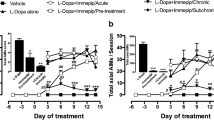Abstract
The present study has compared the abilities of clozapine, haloperidol, chlorpromazine and loxapine to induce dopamine (DA)-receptor hypersensitivity in rats, as measured by the apomorphine response after withdrawal of the antipsychotic drugs. Haloperidol, chlorpromazine and loxapine, but not clozapine, potentiated the apomorphine response during 1–2 weeks after withdrawal. Clozapine, given prior to apomorphine, reduced the responses of the haloperidol and loxapine groups to the control level. The effects of haloperidol and clozapine were quantified in rats with unilateral striatal lesions.
Biochemical investigations showed that tolerance developed to the increase in striatal homovanillic acid (HVA) after chronic treatment with haloperidol, chlorpromazine and loxapine, whereas clozapine (20 mg/kg p.o.) failed to affect the HVA content, and no tolerance developed to the increase seen at 80 mg/kg. Cross-tolerance to the rise in HVA was seen with haloperidol, chlorpromazine and loxapine, but chronic pretreatment with clozapine failed to affect the rise in HVA induced by a single dose of the former compounds.
On the basis of these results, it is predicted that tardive dyskinesias are unlikely to develop after this drug, and that clozapine may attenuate or abolish neuroleptic-induced tardive dyskinesias.
Similar content being viewed by others
References
Andén, N.-E., Dahlström, A., Fuxe, K., Larsson, K.: Functional role of the nigro-neostriatal dopamine neurons. Acta pharmacol. (Kbh.) 24, 263–274 (1966)
Andén, N.-E., Roos, B. E., Werdinius, B.: The occurrence of homovanillic acid in the brain and cerebrospinal fluid and its determination by a fluorimetric method. Life Sci. 2, 448–458 (1963)
Andén, N.-E., Stock, G.: Effect of clozapine on the turnover of dopamine in the corpus striatum and in the limbic system. J. Pharm. Pharmacol. 25, 346–348 (1973)
Angst, J., Bente, D., Berner, P., Heimann, H., Helmchen, H., Hippius, H.: Das klinische Wirkungsbild von Clozapin (Untersuchung mit dem AMP-System). Pharmakopsychiat. 4, 201–211 (1971)
Arnfred, T., Randrup, A.: Cholinergic mechanism in brain inhibiting amphetamine-induced stereotyped behaviour. Acta pharmacol. (Kbh.) 26, 384–394 (1968)
Asper, H., Baggiolini, M., Bürki, H. R., Lauener, H., Ruch, W., Stille, G.: Tolerance phenomena with neuroleptics. Catalepsy, apomorphine stereotypies and striatal dopamine metabolism in the rat after single and repeated administration of loxapine and haloperidol. Europ. J. Pharmacol. 22, 287–294 (1973)
Bürki, H. R., Ruch, W., Asper, H., Baggiolini, M., Stille, G.: Effect of single and repeated administration of clozapine on the metabolism of dopamine and noradrenaline in the brain of the rat. Europ. J. Pharmacol. 27, 180–190 (1974)
Chase, T. N., Holden, E. M., Brody, J. A.: Levodopa-induced dyskinesias. Arch. Neurol. (Chic.) 29, 328–330 (1973)
Fjalland, B., MØller Nielsen, I.: Enhancement of methylphenidate-induced stereotypies by repeated administration of neuroleptics. Psychopharmacologia (Berl.) 34, 105–109 (1974)
Haase, H.-J.: Möglichkeiten und Grenzen der Psychopharmakotherapie mit Tranquilizern und Neuroleptika. Dtsch. med. Wschr. 88, 505–514 (1963)
Ionescu, R., Nica, S. U., Oproiu, L., Niturad, A., Tudorache, B.: Double-blind study in psychopathic behaviour disorders (clozapine and pericyazine). Pharmakopsychiat. 6, 294–299 (1973)
Klawans, H. L., Rubovits, H.: An experimental model of tardive dyskinesia. J. neural. Transmission 33, 235–246 (1974)
de Maio, D.: Preliminary clinical evaluation of a new neuroleptic agent: HF-1854. In: The present status of psychotropic drugs. Pharmacological and clinical aspects. — Proceedings of the VIth International Congress of the Collegium Internationale Neuro-Psychopharmacologicum; Tarragona, April, 1968. Ceretti, A., and Bové, J., eds., pp. 485–488. Amsterdam: Excerpta Medica Foundation 1969 (International Congress Series No. 180)
Miller, R. J., Hiley, C. R.: Anti-muscarinic properties of neuroleptics and drug-induced Parkinsonism. Nature (Lond.) 248, 596–597 (1974)
Rubovits, R., Patel, B. C., Klawans, H. L., Jr.: Amphetamine induced stereotyped behaviour as a model for tardive dyskinesias. Read before the Centennial Symposium on Huntington's Chorea (1972)
Scheel-Krüger, J.: Central effects of anticholinergic drugs measured by the apomorphine gnawing test in mice. Acta pharmacol. (Kbh.) 28, 1–16 (1970)
Schelkunov, E. L.: Adrenergic effect of chronic administration of neuroleptics. Nature (Lond.) 214, 1210–1212 (1967)
Schindler, R.: In: Clozapin Symposion. Wien: Wander GmbH 1973
Simpson, G. M., Varga, E.: Clozapine-A new antipsychotic agent. Current ther. Res. 16, 679–686 (1974)
Snyder, S. H., Greenberg, D., Yamamura, H. I.: Antischizophrenic drugs and brain cholinergic receptors. Affinity for muscarinic sites predicts extrapyramidal effects. Arch. gen. Psychiat. 31, 58–61 (1974)
Stille, G., Lauener, H., Eichenberger, E.: The pharmacology of 8-chloro-11-(4-methyl-1-piperazinyl)-5H-dibenzo[b,e] [1,4]diazepine (clozapine). Farmaco 26, 603–625 (1971)
Tarsy, D., Baldessarini, R. J.: Pharmacologically induced behavioural supersensitivity to apomorphine. Nature New Biol. 245, 262–263 (1973)
Author information
Authors and Affiliations
Rights and permissions
About this article
Cite this article
Sayers, A.C., Bürki, H.R., Ruch, W. et al. Neuroleptic-induced hypersensitivity of striatal dopamine receptors in the rat as a model of tardive dyskinesias. Effects of clozapine, haloperidol, loxapine and chlorpromazine. Psychopharmacologia 41, 97–104 (1975). https://doi.org/10.1007/BF00421063
Received:
Revised:
Issue Date:
DOI: https://doi.org/10.1007/BF00421063




